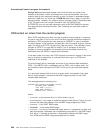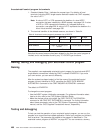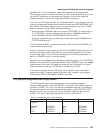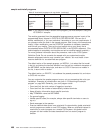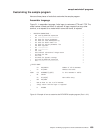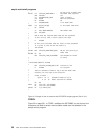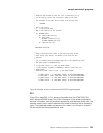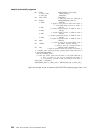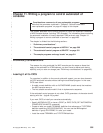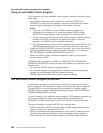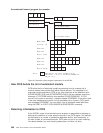PL/I
Figure 33 on page 502, in PL/I, extracts information from the VTAM CINIT RU,
which carries the BIND image. Part of this information is the screen presentation
services information, such as the default screen size and alternate screen size. The
alternate screen size is used to determine the model of terminal that is requesting
logon. The presented models are searched for a match, and if there is no match,
the first model from those presented is used.
.
*
* Redefine the netname so that the last 4 characters (of 7)
* can be used to select the autoinstall model to be used.
*
* The netnames to be supplied are known to be of the form:
*
* HVMXNNN
*
* HVM is the prefix
* X is the system name
* NNN is the address of the terminal
*
01 NETNAME-BITS.
02 FIRST-CHRS PIC X(3).
02 NEXT-CHRS.
03 NODE-LETTER PIC X(1).
03 NODE-ADDRESS PIC X(3).
02 LAST-CHR PIC X(1).
.
.
PROCEDURE DIVISION.
.
.
*
* Select the autoinstall model to be used according to the
* node letter (see above). The models to be used are user
* defined.
*
* (It is assumed that the netname supplied in the commarea by CICS
* has been moved to NETNAME-BITS).
*
* If the node letter is C then use model AUTO2
* If the terminal netname is HVMC289 (a special case) then use
* model AUTO1.
* Otherwise (node letters A,B,D...) use model AUTO3.
*
IF NODE-LETTER = 'C' THEN MOVE 'AUTO2' TO SELECTED-MODELNAME.
IF NEXT-CHRS = 'C289' THEN MOVE 'AUTO1' TO SELECTED-MODELNAME.
IF NODE-LETTER = 'A' THEN MOVE 'AUTO3' TO SELECTED-MODELNAME.
IF NODE-LETTER = 'B' THEN MOVE 'AUTO3' TO SELECTED-MODELNAME.
IF NODE-LETTER = 'D' THEN MOVE 'AUTO3' TO SELECTED-MODELNAME.
.
.
Figure 32. Example of how to customize the DFHZCTDX sample program
sample autoinstall programs
Chapter 10. Writing a program to control autoinstall of terminals 501




